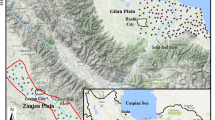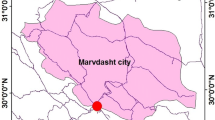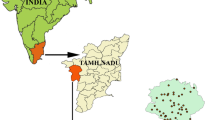Abstract
Water level in aquifer plays the main role in groundwater modeling as one of the input data. In practice, due to aspects of time and cost, data monitoring of water levels is conducted at a limited number of sites, and interpolation technique such as kriging is widely used for estimation of this variable in unsampled sites. In this study, the efficiency of the ordinary kriging (OK) and adaptive network-based fuzzy inference system (ANFIS) was investigated in interpolation of groundwater level in an unconfined aquifer in the north of Iran. The results showed that ANFIS model is more efficient in estimating the groundwater level than OK.











Similar content being viewed by others
Explore related subjects
Discover the latest articles and news from researchers in related subjects, suggested using machine learning.References
Cameron, K., & Hunter, P. (2002). Using spatial models and kriging techniques to optimize long-term ground-water monitoring networks: A case study. Environmetrics, 13, 629–656. doi:10.1002/env.582.
Chang, L. -C., & Chang, F. -J. (2001). Intelligent control for modeling of real-time reservoir operation. Hydrological Processes, 15(9), 1621–1634. doi:10.1002/hyp.226.
Chen, S. H., Lin, Y. H., Chang, L. C., & Chang, F. J. (2006). The strategy of building a flood forecast model by neuro-fuzzy network. Hydrological Processes, 20(7), 1525–1540. doi:10.1002/hyp.5942.
Cheng, C. B., & Lee, E. S. (1999). Applying fuzzy adaptive network to fuzzy regression analysis. Computers & Mathematics with Applications (Oxford, England: 1987), 38, 123–140. doi:10.1016/S0898-1221(99)00187-X.
Davis, J. C. (2002). Statistics and data analysis in geology (2nd ed.). New York: Wiley 1986.
Desbarats, A. J., Logan, C. E., Hinton, M. J., & Sharpe, D. R. (2002). On the kriging of groundwater table elevations using collateral information form a digital elevation model. Geological Survey of Canada, 255, 25–38.
Diamond, P. (1988). Interval valued random functions and the kriging of intervals. Mathematical Geology, 20, 145–165. doi:10.1007/BF00890251.
Hasebe, M., & Nagayama, Y. (2002). Reservoir operation using the neural network and fuzzy systems for dam control and operation support. Advances in Engineering Software, 33, 245–260. doi:10.1016/S0965-9978(02)00015-7.
Isaaks, E. H., & Srivastava, R. M. (1989). An introduction to applied geostatistics. New York: Oxford University Press.
Jang, J. -S. R. (1993). ANFIS: adaptive network based fuzzy inference system. IEEE Transactions on Systems, Man, and Cybernetics, 23, 665–684. doi:10.1109/21.256541.
Jang, C. S., & Liu, C. W. (2004). Geostatistical analysis and conditional simulation for estimating the spatial variability of hydraulic conductivity in the Choushui river alluvial fan. Taiwan. Hydrological Processes, 18, 1333–1350. doi:10.1002/hyp.1397.
Lee, E. S. (2000). Neuro-fuzzy estimation in spatial statistics. Journal of Mathematical Analysis and Applications, 249, 221–231. doi:10.1006/jmaa.2000.6938.
Ma, T. S., Sophocleous, M., & Yu, Y. S. (1999). Geostatistical applications in ground-water modeling in south–central Kansas. Journal of Hydrologic Engineering, 4(1), 57–64. doi:10.1061/(ASCE)1084-0699(1999)4:1(57).
Marsily, G. D., & Ahmed, S. (1987). Application of kriging techniques in groundwater hydrology. Journal of the Geological Society of India, 29(1), 57–79.
Mukhopadhyay, A. (1999). Spatial estimation of transmissivity using artificial neural network. Ground Water, 37(3), 458–464. doi:10.1111/j.1745-6584.1999.tb01125.x.
Nash, J. E., & Sutcliffe, J. V. (1970). River flow forecasting through conceptual models. Journal of Hydrology (Amsterdam), 10, 282–290. doi:10.1016/0022-1694(70)90255-6.
Nayak, P. C., Sudheer, K. P., Rangan, D. M., & Ramasastri, K. S. (2004). A neuro-fuzzy computing technique for modeling hydrological time series. Journal of Hydrology (Amsterdam), 291, 52–66. doi:10.1016/j.jhydrol.2003.12.010.
Piotrowski, J. A., Bartels, F., Salski, A., & Schmidt, G. (1996). Geostatistical regionalization of glacial aquitard thickness in northwestern Germany, based on fuzzy kriging. Mathematical Geology, 28(4), 437–448. doi:10.1007/BF02083655.
Ponnambalam, K., Karray, F., & Mousavi, S. J. (2003). Minimizing variance of reservoir systems operations benefits using soft computing tools. Fuzzy Sets and Systems, 139, 451–461. doi:10.1016/S0165-0114(02)00546-8.
Rosenblatt, F. (1958). The perceptron: a probabilistic model for information storage and organization in the brain. Psychological Review, 65, 386–408. doi:10.1037/h0042519.
Sepaskhah, A. R., Ahmadi, S. H., & Nikhbakht Shahbazi, A. R. (2004). Geostatistical analysis of sorptivity for a soil under tilled and no-tilled conditions. Soil & Tillage Research, 86(2), 237–245.
Setnes, M., Babuska, R., & Verbruggen, H. B. (1998). Transparent fuzzy modeling. International Journal of Human–Computer Studies, 49, 159–179. doi:10.1006/ijhc.1998.0197.
Takagi, T., & Suegeno, M. (1985). Fuzzy identification of systems and its application to modeling and control. IEEE Transactions on Systems, Man, and Cybernetics, 15, 116–132.
Tutmez, B., Hatipoglu, Z., & Kaymak, U. (2006). Modelling electrical conductivity of groundwater using an adaptive neuro-fuzzy inference system. Computers & Geosciences, 32, 421–433. doi:10.1016/j.cageo.2005.07.003.
Wang, Y., Ma, T., & Luo, Z. (2001). Geostatistical and geochemical analysis of surface water leakage into groundwater on a regional scale: a case study in the Liulin karst system, northwest China. Journal of Hydrology (Amsterdam), 246, 223–234. doi:10.1016/S0022-1694(01)00376-6.
Author information
Authors and Affiliations
Corresponding author
Rights and permissions
About this article
Cite this article
Kholghi, M., Hosseini, S.M. Comparison of Groundwater Level Estimation Using Neuro-fuzzy and Ordinary Kriging. Environ Model Assess 14, 729–737 (2009). https://doi.org/10.1007/s10666-008-9174-2
Received:
Accepted:
Published:
Issue Date:
DOI: https://doi.org/10.1007/s10666-008-9174-2
Keywords
Profiles
- S. M. Hosseini View author profile




